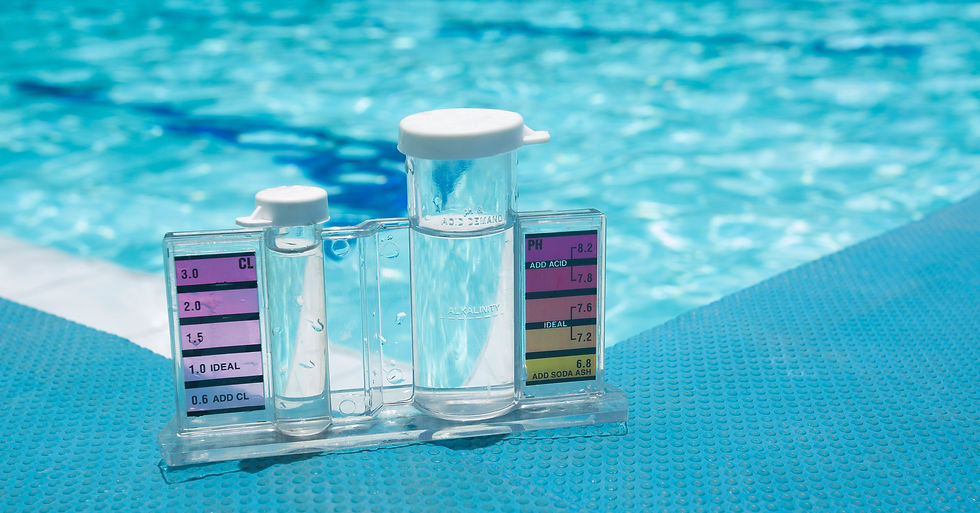The Importance of Water Chemistry for Healthy Koi
- Tri-Star Koi
- Aug 22
- 3 min read
By Tri-Star Koi
When it comes to keeping koi healthy and vibrant, water chemistry is everything. It’s the foundation of a thriving pond environment, yet it’s often misunderstood or overlooked by hobbyists new and old. At Tri-Star Koi, we stress that mastering water chemistry is one of the best things you can do for your fish.
Your koi live in water 24/7, so the quality and balance of that water directly affect their health, growth, and longevity. Let’s break down the key water chemistry factors every koi keeper should monitor—why they matter, what to watch for, and how to keep everything in check.
Key Water Chemistry Parameters
1. pH — The Acid-Base Balance
pH measures how acidic or alkaline your pond water is on a scale of 0 to 14, with 7 being neutral. For koi, the ideal pH range is generally between 7.0 and 8.5.
Why it matters: Koi can tolerate slight fluctuations, but sudden or extreme changes can stress them and damage their skin and gills.
Watch out for: pH crashes (rapid drops) or spikes due to organic waste buildup or runoff. A stable pH is crucial.
How to manage: Use buffering agents like KH (carbonate hardness) to stabilize pH, and avoid introducing acidic substances without testing first.
2. Ammonia — The Silent Killer
Ammonia (NH3) is a toxic compound that comes from fish waste, uneaten food, and decaying organic matter. Even low levels can harm your koi.
Why it matters: Ammonia damages gills, reduces oxygen uptake, and weakens the immune system—leading to disease or death.
Watch out for: Any detectable ammonia should be treated seriously. The ideal level is 0 ppm (parts per million).
How to manage: Good filtration, regular water changes, and not overfeeding keep ammonia in check.
3. Nitrites — The Next Danger
Nitrites (NO2-) are produced when beneficial bacteria start breaking down ammonia but haven’t yet converted nitrites to nitrates.
Why it matters: Nitrites interfere with oxygen transport in the fish’s blood, leading to “brown blood disease.”
Watch out for: Like ammonia, nitrites should be 0 ppm. Any spike indicates an unbalanced or new biological filter.
How to manage: Ensure your biofilter is established and working well; regular water changes can help lower nitrites.
4. Nitrates — The Less Toxic Waste
Nitrates (NO3-) are the end product of the nitrogen cycle and are much less toxic, but they still matter.
Why it matters: High nitrate levels contribute to poor water quality, algae blooms, and long-term stress on koi.
Watch out for: Keep nitrates below 40 ppm for a healthy pond. Levels above 50 ppm should trigger a water change.
How to manage: Regular water changes can keep these levels down.
5. KH (Carbonate Hardness) — The pH Stabilizer
KH acts as a buffer that prevents rapid changes in pH.
Why it matters: Without adequate KH, your pH can swing wildly, causing stress or shock.
Watch out for: Low KH (below 80 ppm) means your pH is vulnerable to crashes.
How to manage: Add baking soda or commercial buffers to raise KH if needed.
How Often Should You Test?
Regular testing is the key to maintaining good water chemistry. At Tri-Star Koi, we recommend:
Testing weekly during the growing season and more often if you see koi acting off
Testing ammonia, nitrite, nitrate, pH, and KH each time
Testing immediately after adding new fish or performing major water changes
Why Water Chemistry Matters Beyond Just Numbers
Balanced water chemistry creates an environment where your koi’s immune system thrives, parasites stay at bay, and beneficial bacteria flourish. Poor water chemistry, on the other hand, is the root cause of many koi health problems—from ulcers to parasites to sudden death.
The good news is that water chemistry is manageable. With good filtration, regular testing, proper feeding, and timely water changes, you can create a stable pond environment that supports your koi’s best life.
Water chemistry is like the heartbeat of your pond—if it’s out of rhythm, the whole system suffers. At Tri-Star Koi, we’ve seen firsthand how mastering water chemistry transforms koi health and pond success.
Your koi depend on you to keep their home balanced and healthy.
Please Check out our Store as we carry a freshwater Test kit
Link:
— Marlon @ Tri-Star Koi





